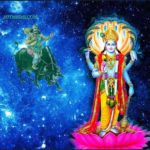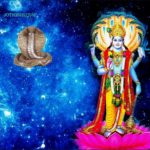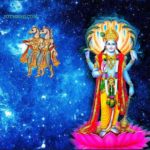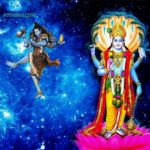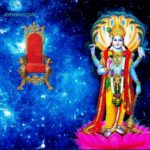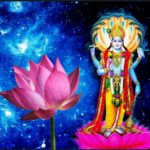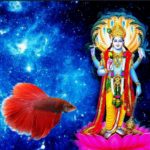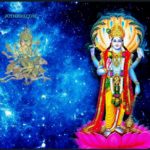Introduction to Vishnu Sahasranama
“Vishnu” indicates “The All Pervading One”, “Who is present everywhere”, “One who is free from bondages”, one who removes negativity from our lives”.
- Adi Shankaracharya in his commentary on Vishnu Sahasranamam indicates Vishnu means “Omnipresent “and Eliminator of darkness: Poison (Vish – Nu) or “Supreme Wisdom”
- Conceived as the Protector or Preserver, described as dark complexioned of water-filled clouds and as having four arms. Vishnu is depicted in Blue Colour, holding a Padma (lotus flower) in the lower left hand, the Gada (mace) in the lower right hand, the Shankha (conch) in the upper left hand and the Discus weapon Sudarshana Chakra in the upper right hand.
- Vishnu’s abodes are:
- Beyond Material Universe – Vaikuntha, also known as Paramdhama, and is the realm of eternal bliss and happiness and the highest stage for those who have attained Moksha and is beyond the material realm.
- Material universe -Ksheera Sagara (the ocean of milk), where he reclines and rests on Ananta Shesha – thousand headed serpent.
- “Sahasranama” means Sahasra (thousand) and Nama (Names) – Thousand Names of Vishnu.
- The main body of Vishnu Sahasranama contains 108 stanzas written by Shri Veda Vyasa in Mahabharata, Anushasana Parva.
The Legend of Vishnu Sahasranama:
After the Mahabharata war, Yudhistra was crowned the king and had queries regarding Dharma to follow in Life. Pancha Pandavas along with Shri Krishna and Shri Veda Vyasa went to Bhishmacharya (lying in a death Bed of Arrows and waiting to depart from the physical body to the lotus feet of the lord) for a solution and view point as he was one of the most learned Acharya’s at that point in time.
Questions Asked were:
- Who is the greatest Lord in the world? (Kimekam dhaivatam loke?)
- Who is the one refuge of all? (Kim vaapyekam parayanam?)
- By glorifying whom can man attain peace and prosperity? (Stuvantam kam prapnuyuh manavah subham?)
- By worshipping whom can man reach auspiciousness? (Kam arcanat prapnuyuh manavaah subham?)
- What is the greatest Dharma? (Ko dharmah sarva dharmanaam bhavatah paramo matah?)
- By doing Japa of what, whom, can one reach beyond the bonds and cycle of birth and death? (Kim japam mucyate jantur janma samsara bandhanath?)
Bhishma answered all these questions by reciting one thousand names of Lord Vishnu. He also mentioned that by meditating on these names one can reach the auspicious state.
Benefits of chanting Vishnu Sahasranamam
Vishnu Sahasranama should be heard or chanted with full devotion and purity of heart. It is observed that by doing this one could fulfill all desires and overcome any difficulty.
- Assists in removing obstacles, diseases, suffering and helps attain Moksha.
- Bestows name, fame, wealth, health, beauty, victory, freedom, happiness, knowledge and growth
- Removes all evils like jealousy, greed and cleanses the mind.
- Helps remove various curses and misfortunes.
- Considered a universal remedy to pacify and empower all planets in one’s birth chart.
- Helps address problems with begetting progeny and problems affecting children.
- Affirms spiritual progress and grace of Lord Vishnu.
However, the ultimate aim of chanting is not Goodness to be achieved in the Material World but unision of the soul with the parabrahman (The ultimate Reality and Wisdom) reaching a stage of eternal bliss.
The structure of Vishnu Sahasranama
4 Shlokas in each of the 27 constellations/ Nakshatra – Totaling 108 Shlokhas in Vishnu Sahasranamam
Each verse can be chanted for each Constellation/ Nakshatra starting from Ashwini and ending at Revathi
Every name has more than one meaning but we have tried to list the most important meaning.
Some names are repeated multiple time in different context and with a different meaning.
The various constellations/ Nakshatras
- Ashwini
- Bharani
- Krittika
- Rohini
- Mrigashira
- Ardra
- Punarvasu
- Pushya
- Ashlesha
- Magha
- Purva or Purva Phalguni
- Uttara or Uttara Phalguni
- Hasta
- Chitra
- Svati
- Visakha
- Anuradha
- Jyeshtha
- Mula
- Purva Ashadha
- Uttara Ashadha
- Sravana
- Sravistha or Dhanishta
- Shatabhisha or Satataraka
- Purva Bhadrapada
- Uttara Bhadrapada
- Revathi




